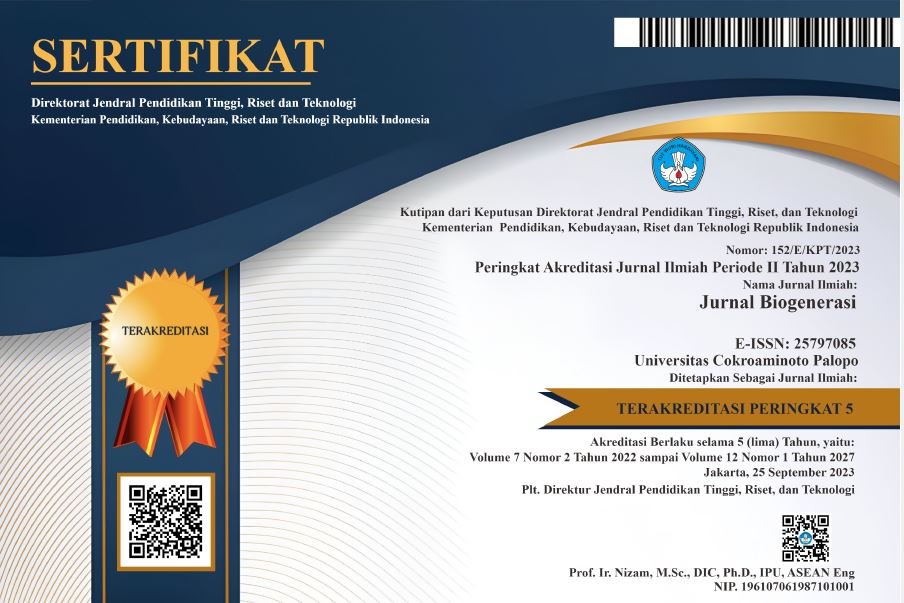EKSPLORASI DAN SKRINING FITOKIMIA TUMBUHAN OBAT TRADISIONAL MASYARAKAT ASLI PAPUA DI DESA SAIRO DAN DESA LEBAU KABUPATEN MANOKWARI
DOI:
https://doi.org/10.30605/biogenerasi.v9i1.3477Keywords:
Medicinal plants, Papua, exploration, phytochemistryAbstract
Indigenous Papuans utilize plants around them for traditional medicine. This study aims to determine the types of traditional medicinal plants used by indigenous Papuans in Sairo Village and Lebau Village, as well as the content of secondary metabolites of these plants to enrich pharmacological data. The method used was interviews and field surveys followed by phytochemical screening to determine the content of compounds in plants used as medicine. The results obtained in this study are 27 types of medicinal plants used by indigenous Papuans in in Sairo Village and Lebau Village of Manokwari Regency. Plant parts are utilized and the way they are used varies for various diseases. The results of phytochemical screening show that there are saponins, alkaloids and tannins that vary in medicinal plants.
Downloads
References
Dewick, P.M., 2009. Medicinal Natural Product, A Biosynthetic Approach, 3rd Edition. John Wiley and Son Publisher.
Heinrich, M., Mah, J., & Amirkia, V. 2021. Alkaloids Used as Medicines: Structural Phytochemistry Meets Biodiversity—An Update and Forward Look. Molecules 26 (7): 1-18.
Kusmana, C. and Hikmat, A. 2015. Keanekaragaman Hayati Flora di Indonesia. Jurnal Pengelolaan Sumberdaya Alam dan Lingkungan 5 (2): 187-198.
Mabel, Y., H. Simbala., R. Koneri. 2016. Identifikasi dan Pemanfaatan Tumbuhan Obat Suku Dani di Kabupaten Jayawijaya, Papua. Jurnal MIPA Unsrat Online. 5 (1): 103-107.
Maturbongs, A. C., Erari, D. K., Mogea, R. A., Maturbongs, R.A., 2023. Potensi Ekstrak Metanol Daun Dodonaea viscosa (L.) Jacq Sebagai Agen Antibakteri Patogen. Jurnal Vogelcop 3 (2): 1-9.
Raodah. 2019. Pengetahuan Lokal Tentang Pemanfaatan Tanaman Obat Pada Masyarakat Tolaki di Kabupaten Konawe Sulawesi Tenggara. Pangadereng 5 (1): 46-63.
Rijai, L. 2011. Penentuan Kriteria Ilmiah Potensi Tumbuhan Obat Unggulan. J. Trop. Pharm. Chem. 1 (2): 125-133.
Shailesh., Patwekar, L., B. Arvind, S., S. Manoj, Gaikwand., R. Snehal, Pedewad., P. Ashwini, Potulwar. 2015. Standardization of Herbal Drugs: An Overview. The Pharma Innovation Journal; 4(9): 100-104.
Sharma, K., Kaur, R., Kumar S., Saini, R. K., Sharma S., Pawde, S., & Kumar, V. 2023. Saponins: A Concise Review on Food Related Aspects, Applications and Health Implications. Food Chemistry Advances Volume 2, 100191.
Wahid, A. R. dan Safwan. 2020. Srining Fitokimia Senyawa Metabolit Sekunder Terhadap Ekstrak Tanaman Patah Tulang (Euphorbia tirucalli L.). Jurnal Ilmu Kefarmasian 1(1): 24-27.
Downloads
Published
How to Cite
Issue
Section
License
In submitting the manuscript to the journal, the authors certify that:
- They are authorized by their co-authors to enter into these arrangements.
- The work described has not been formally published before, except in the form of an abstract or as part of a published lecture, review, thesis, or overlay journal.
- That it is not under consideration for publication elsewhere,
- That its publication has been approved by all the author(s) and by the responsible authorities – tacitly or explicitly – of the institutes where the work has been carried out.
- They secure the right to reproduce any material that has already been published or copyrighted elsewhere.
- They agree to the following license and copyright agreement.
License and Copyright Agreement
Authors who publish with this journal agree to the following terms:
- Authors retain copyright and grant the journal right of first publication with the work simultaneously licensed under Creative Commons Attribution License (CC BY 4.0) that allows others to share the work with an acknowledgment of the work's authorship and initial publication in this journal.
- Authors are able to enter into separate, additional contractual arrangements for the non-exclusive distribution of the journal's published version of the work (e.g., post it to an institutional repository or publish it in a book), with an acknowledgment of its initial publication in this journal.
- Authors are permitted and encouraged to post their work online (e.g., in institutional repositories or on their website) prior to and during the submission process, as it can lead to productive exchanges, as well as earlier and greater citation of published work.


.png)

